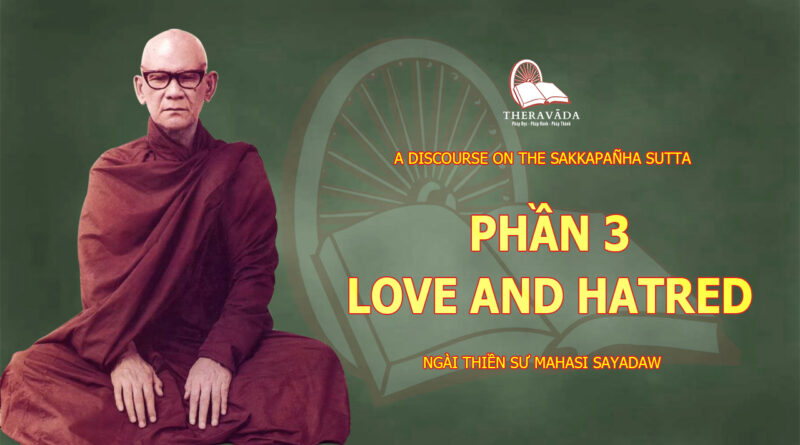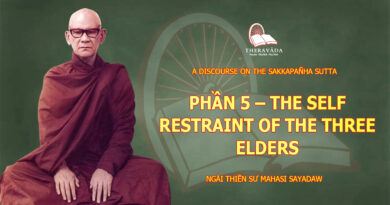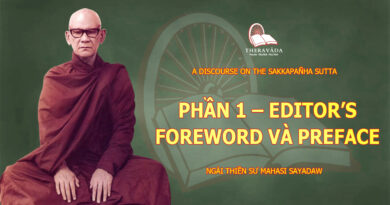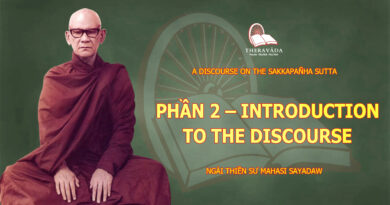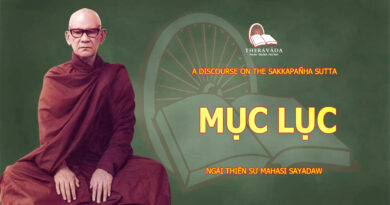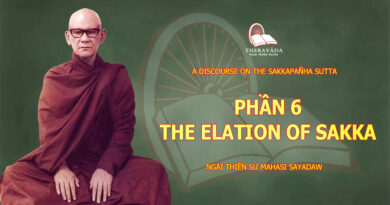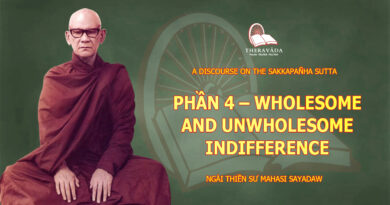Nội Dung Chính
Phần 3 – Love and Hatred
– Love and Hatred
– Desire is the Cause of Love and Hatred
– The Conquest of Craving
– Pleasant Feeling and Unwholesome Thoughts
– Wholesome Joy
– Insight Meditation
– Unpleasant Feelings to be Sought or Avoided
Love and Hatred
“Venerable sir, what is the cause of envy and meanness? What must we remove to be free from them?”
The Buddha answered, “O King of devas! Envy and meanness are caused by the objects of love and hatred. If there were no such objects there would be no envy and meanness.” As the Buddha pointed out, the way to end suffering is to remove its cause, and the cause of mankind’s unhappiness is love and hatred. It is like the treatment of disease by a competent physician who seeks its cause and eliminates it.
The objects of love are the living and non-living things that please us, such as men, women, sights, sounds, etc., and the objects of hatred are those things that displease us. We envy someone we dislike who owns valuable objects. Ill-will plagues us when we do not want others to have the objects to which we are attached. So envy and meanness have their roots in hated and cherished persons and objects. It is usually someone we hate who is the object of our envy. However, if the person who excels us happens to be our loved one, it is a cause not for envy but for joy. A boy who outshines his parents does not arouse envy in them — on the contrary they will pride themselves on his superior qualities.
The man who is mean wants to deny others the kind of wealth that he has, the use of his possessions and the opportunity to associate with his friends. Jealous men and women frown on their spouses when they have close relationships with members of the opposite sex or even engage in friendly conversation. In short, meanness is the inclination to be excessively possessive, and to oppose any close contact between other people and the things one cherishes, and so it is rooted in love and hatred.
Desire is the Cause of Love and Hatred
Sakka then asked the Buddha about the cause of love and hatred. The Buddha said that desire was the cause of love and hatred. Here, the desire the Buddha referred to is not wholesome desire but the desire associated with pleasure and craving (taṇhā chanda).
Desire is of five kinds:
- The insatiable desire to seek sensual objects. This desire is the driving force behind men’s ceaseless activities until the moment of death in each existence.
- The insatiable desire to get sensual objects. When one desire is fulfilled, another arises and so in this way the acquisitive drive never ends. No wonder that even millionaires crave for more wealth and money instead of being content with what they have.
- The insatiable desire to consume various sensual objects and material goods. People who like shows, songs, etc., never tire of enjoying them.
- The insatiable desire to store gold, silver, etc., or to hoard money in any form to be used in case of an emergency.
- The desire that some people have to give money to their followers, employees, etc.
These five kinds of desire lead to love and hatred. Those objects and living beings that help to fulfil our desires cause love to arise, while those that obstruct our desires cause hatred.
Sakka then asked the Buddha about the origin of desire. The Buddha answered that desire is caused by discursive thinking (vitakka). According to the Commentary, vitakka means thinking and deciding. This vitakka is of two kinds: one is based on desire while the other has its origin in views. In other words, you think and decide when you regard a sense-object, or a person or another living being as pleasant and desirable. Thus, if you are not mindful at the moment of seeing, hearing, etc., you think and decide. This mental action leads to craving and attachment.
Then Sakka asked the Buddha about the cause of discursive thinking. The Buddha replied that discursive thinking is due to perception, which tends to expand or diffuse (papañca-saññā). There are three such kinds of perception: craving (taṇhā), conceit (māna) and wrong-view (diṭṭhi). Like a small photograph that can be enlarged, every mental image or thought lends itself to expansion. An unmindful person usually falls prey to one of these agents of expansion. He expands every sense-object that he perceives and remembers because of his attachment, conceit or wrong-view.
The Conquest of Craving
At the moment of seeing one sees only visible form, but then reflection brings into play craving, conceit and wrong-view. Craving makes the form appear pleasant and amplifies it. The same happens with conceit and wrong-view. So later, every recollection of the moment of seeing leads to thinking and decision, which in turn causes desire. Again, desire leads to love and hatred that make a man prey to envy and ill-will. These cause the frustration and suffering of humanity.
In response to Sakka’s request, the Buddha explained the practice for overcoming craving, conceit and wrong-view. According to him, there are two kinds of pleasant feeling and two kinds of unpleasant feeling: the pleasant or unpleasant feeling that we should harbour and the pleasant or unpleasant feeling that we should avoid. Then there is neutral feeling that we have when we are neither happy nor unhappy. This is also of two kinds.
Pleasant, unpleasant or neutral feeling is to be harboured if it leads to wholesome states of consciousness; it should be avoided if it leads to unwholesome states of consciousness. The Commentary describes this teaching as insight practice on the noble path.
The Pāḷi text of the Buddha’s teaching may be translated as follows:
“Sakka, I teach two kinds of pleasant feeling: the pleasant feeling that is to be harboured and the pleasant feeling that is to be avoided. If you know that a pleasant feeling helps to develop unwholesome states of consciousness and to hamper wholesome ones, you should not harbour such a feeling. If you know that a pleasant feeling helps to develop wholesome states of consciousness and to hamper unwholesome ones, you should harbour such a feeling. The pleasant feeling is of two kinds: one, which is bound up with thinking and reflection and the other, which is unconnected with these mental activities. Of these two the pleasant feeling that has nothing to do with thinking and reflection is far superior.”
Pleasant Feeling and Unwholesome Thoughts
Pleasant feelings that lead to unwholesome thoughts are rooted in sensual things. Most people are preoccupied with such things as sex and food. If they get what they want, they rejoice. However, their joy leads to more desire, and so for many people their so-called happiness is founded on desire. If this desire is not fulfilled they are frustrated and unhappy. This means the emergence of unwholesome thoughts, which bring the agents of expansion, namely craving, conceit and wrong-view, into play. The pleasant feelings that we should avoid are mentioned in the Sāḷāyatanavibhaṅga Sutta of the Majjhimanikāya. The discourse likens sense-objects to human dwellings because they keep people in confinement. People derive pleasure from contact with them or from memories of that contact. There are six kinds of pleasant feelings rooted in the six sense-objects and their respective sense-organs.
The way to avoid pleasant, but unwholesome, feelings is to be mindful at the moment of seeing, etc. If sensual thoughts cause pleasure, the meditator must note and reject them. However, a beginner cannot follow and note all the mental processes, so he starts with the object of contact and becomes aware of one of the primary elements: solidity (paṭhavī), cohesion (āpo), temperature (tejo) and motion (vāyo).
In the Satipaṭṭhāna Sutta the Buddha says, “When walking he [the meditator] knows, ‘I am walking’ (Gacchanto vā gacchāmī’ti pajānāti).” This saying refers to clear awareness of rigidity and motion (vāyo), but as he notes walking, the meditator is also aware of the hardness and softness (paṭhavī), the warmth and coldness (tejo) and the heaviness and dampness (āpo) in the feet and the body. Though the element of āpo is intangible it can be known through contact with the other elements that are bound up with it.
Meditators at our meditation centre in Rangoon begin with contact and motion in the abdomen, which are the easiest and most obvious to note while sitting. The tenseness and motion in the abdomen are the marks of the vāyo element. They practise noting (in their own language) the rising and falling of the abdomen. This practice has helped many meditators to attain insights and make significant progress on the holy path.
In the beginning, the meditator constantly watches the abdominal rising and falling. He notes any mental event that occurs while engaged in such concentration. A feeling of joy may arise but it disappears when it is noted and usually does not intrude if the meditator keeps on watching the rising and falling. When the Buddha speaks of unwholesome joy, this means that we should focus on mind and matter in order to head off sensual joy, and that if such joy arises we should note it and reject it at once.
Wholesome Joy
Then there is wholesome joy, which the Buddha describes in the same discourse as follows. Having realised the impermanence and dissolution of matter, the meditator knows that all matter that he has seen before and is seeing now is subject to impermanence (anicca) and unsatisfactoriness (dukkha). This insight knowledge causes joy, and such joy may be described as the pleasant feeling that is rooted in liberation from sensual desire.
This is part of the teaching in the discourse. The Commentary adds that the meditator is joyful because he attains insight into impermanence, etc., as a result of his mindfulness of the six sense-objects. Such joy is wholesome and desirable.
The Commentary describes four kinds of wholesome joy:
- the joy due to renunciation of worldly affairs,
- the joy associated with insight practice,
- the joy based on contemplation of the Buddha, etc., and
- the joy resulting from absorption in the first jhāna, etc.
Some people are joyful when they think of their renunciation of worldly affairs, their ordination as bhikkhus and the practice of the monastic discipline, concentration and so forth. Feelings of joy also arise when they hear a discourse on the Dhamma or when they go to a meditation centre for the practice of insight meditation. This joy is wholesome since it is dissociated from secular life.
The joy dependent on insight may be the joy that arises while one is being mindful. In particular the highest joy is the joy associated with the knowledge of arising and passing away (udayabbaya-ñāṇa).
The joy that we have when we contemplate the Buddha, etc., is obvious. The Commentaries say that concentration on the joy derived from the six contemplations on the Buddha, the Dhamma, the Saṅgha, on one’s morality, on one’s generosity, and on heavenly beings, can bring about knowledge and fruition of the path. Even Arahantship may be attained if the meditator notes and reflects on the dissolution and cessation of joy (pīti) that is born of these six contemplations. Pīti means joy and obviously the joy derived from the six contemplations is wholesome. So, too, is the joy based on the three jhānas or their access concentration (upacāra samādhi).
Of the four kinds of renunciation, joining the Saṅgha means freedom from marital responsibilities. One who practices insight meditation (vipassanā) is also aloof from attachment and all sensual objects. So the Commentary on the Itivuttaka describes ordination, the first jhāna, nibbāna, vipassanā and all wholesome dhammas as renunciation (nekkhamma). The joy that is marked by thinking and reflection is of two kinds: happiness (sukha) that is associated with access-concentration (upacāra samādhi) and happiness associated with the first jhāna. Then, as mentioned before, there are various types of mundane joy: joy over one’s ordination, joy that results from insight practice, the joy of contemplating the Buddha, etc. Again, we have four kinds of supramundane joy associated with the four paths of the first jhāna.
Superior to these types of joy are those that have nothing to do with thinking and reflection (vitakka-vicāra). This is the attribute of the second jhāna; which is marked by joy (pīti), bliss (sukha), and one-pointedness of mind (ekaggatā); and the attribute of the third jhāna, which is also marked by bliss and one-pointedness. Such jhānic joy is mundane joy. The joy derived from the four supramundane paths and from the second and third jhānas is free from thinking and reflection and is therefore wholesome. These second and third jhānic joys are far superior to the first jhānic joy or the joy associated with wholesome thoughts in the sensual sphere; and so too is the joy of insight resulting from attentiveness to the second and third jhānic joy.
A discussion of these joys that are with or without thinking and reflection, is beyond the comprehension of those who have little knowledge of the scriptures. It can be understood thoroughly only by those who have attained jhāna. According to the Commentary, when Sakka asked the Buddha how to overcome desire (taṇhā), conceit (māna), and wrong-view (diṭṭhi), he was asking the Buddha about the practice of insight on the noble path. The Buddha stressed wholesome pleasure, wholesome displeasure, and wholesome indifference as the remedy. It may be hard for unenlightened people to understand this, but the Buddha’s answer is relevant to the question.
For the devas, mind is more obvious than matter, and among the elements of mind, feeling is more obvious than the others. So the Buddha told Sakka to contemplate his feelings (vedanā). In many of the Buddha’s teachings on insight meditation, contemplating matter takes precedence over contemplating consciousness. This is also true of the Sakkapañha Sutta, but here no mention is made of matter since it is implicit in the contemplation of feeling.
Insight Meditation
The object of insight practice is to note all psycho-physical phenomena that arise from contact with sense-objects. It involves the effort to observe empirically all phenomena as they really are, together with their characteristics such as impermanence, etc. At first the meditator cannot focus on every mental and physical process and so he should begin with a few obvious events. When he walks he should note ‘walking’ and so on. By watching every bodily action he usually becomes aware of the element of motion and other primary elements. This accords with the teaching of the Satipaṭṭhāna Sutta: “When walking he [the meditator] knows, ‘I am walking’ (Gacchanto vā gacchāmi’ti pajānāti).”
The meditator tends to be slack if he focuses on just one posture, for example, sitting. So, to keep him alert, we instruct him to focus on the rising and falling of the abdomen. With the development of concentration, he becomes aware of the element of motion (vāyo) whenever he focuses on the rising and falling. Later on the distinction between the rising and consciousness; between the falling and consciousness; between the lifting of the foot and consciousness and so forth, becomes clear to him. This is analytical knowledge of body and mind (nāmarūpapariccheda-ñāṇa).
With the further development of concentration, the meditator knows that he bends his hand because of the desire to bend it, that he sees because he has eyes and there is an object to be seen, that he knows because of an object to be known; that he does not know because of his unmindfulness; that he likes a thing because of his ignorance; that he seeks to fulfil his desire because of his attachment; that good or bad results follow from his actions and so on. This is knowledge by discerning conditionality (paccayapariggaha-ñāṇa), or insight into the primacy of the law of cause and effect.
This is followed by knowledge of comprehension (sammasana-ñāṇa), which means insight into the impermanent, unsatisfactory and impersonal characteristics of all phenomena — an insight born of reflection on their arising and passing away.
Then the meditator knows that everything arises and vanishes rapidly. His perception is so keen that nothing escapes his attention. He tends to see lights and to be overly ecstatic and joyful. This pleasant feeling arises together with the extraordinary insight into the flux of mind and matter. It surpasses all other kinds of joy and is described as a mental state that we should welcome. The Dhammapada speaks of the surpassing joy and ecstasy arising in the meditator who contemplates the Dhamma rightly, i.e. the impermanence of mind and matter. This state of consciousness is called the Deathless (amata) because it is the forerunner of nibbāna, which the meditator will surely attain if he strives for it with faith, will and diligence.
Rapture and joy are called pamojja and pīti in Pāḷi. Pamojja is the rapture that occurs with the emergence of knowledge of comprehension (sammasana-ñāṇa). Pīti means the extreme joy that accompanies the knowledge of arising and passing away (udayabbaya-ñāṇa). It develops while the meditator is mindful of the rising and falling of the abdomen, or of the sensations in the body, or while his attention is focused on his bodily movements. He rarely suffers unbearable pain. If pain does occur sometimes, it vanishes instantly as soon as he notes it. Then he feels extremely elated and this elation continues to be intense as long as he is mindful of the rapidity with which each phenomenon arises and passes away.
As with the first three jhānas, the meditator feels very happy when he or she attains the knowledge of arising and passing away. At this stage he describes his happiness as an ineffable experience that surpasses all similar states of consciousness. In the Sakkapañha Sutta it is called sevitabbasomanassa, that is, the pleasant feeling that we should seek.
Unpleasant Feelings to be Sought or Avoided
The discourse mentions two kinds of unpleasant feeling: the unpleasant feeling that leads to unwholesome kamma (acts, words or thoughts) and the unpleasant feeling that leads to wholesome kamma. The former is to be avoided whilst the latter is to be welcomed. Unpleasant feelings that result in wholesome kamma are commendable, being conducive to the practice of jhāna, the holy path and its fruition, but they should not be deliberately sought.
The Saḷāyatanavibhaṅga Sutta tells us what kind of sorrow we should welcome and what kind of sorrow we should avoid. We usually grieve over the lack of pleasant, desirable sense-objects in the present or over our failure to have acquired these objects in the past. We are unhappy when we have to face dangers and unpleasant objects, when we worry over the possibility of future suffering and danger, or when we think of our past suffering. Such unpleasant feelings do us no good and produce only pain and unwholesome thoughts.
Those who harbour unpleasant feelings cannot contemplate the Buddha image with zeal and concentration because they are so distracted. A calm mind is essential if contemplation of the Buddha is to be worthwhile. Without it there will be only unwholesome thoughts. These feelings are also a hindrance to good deeds so we should try to overcome them. Yet some people seem to welcome suffering and may not like you if you tell them not to grieve over the loss of their loved ones. On the contrary, they may thank you when you say something to justify their grief.
We should keep in mind the law of kamma — the Buddha’s teaching that everything happens according to one’s actions — and bear our misfortunes calmly. The best remedy in a crisis is the practice of tranquillity or insight meditation. If sorrow, grief or depression afflicts us during our meditation, such unwholesome states of consciousness must be noted and removed. The Buddha describes the satipaṭṭhāna method as the only way to get over grief and to end all suffering. So long as we remain mindful, as explained in the satipaṭṭhāna teaching, we need never feel depressed, and if depression arises, it passes away as soon as we focus our attention on it.
There are many things in life that make us unhappy: frustrated desires, lack of success, loss of property and so forth. Brooding over our misfortunes leads to depression but we should overcome it through mindfulness. Our method is to watch constantly the abdominal rising and falling, the fact of sitting, etc.
The practice of mindfulness was crucial to Sakka, for in the face of his imminent death, which would surely bring about the loss of heavenly bliss and sensual pleasure, he was very depressed. So the Buddha’s teaching was realistic and very opportune.
I will now give a translation of the Pāḷi text in the Saḷāyatanavibhaṅga Sutta about the unpleasant feeling that we should welcome.
“After having observed and realised the impermanence of visual forms, their dissolution and passing away, the meditator gains a true insight into the nature of things as they are, that is, into their impermanence, unsatisfactoriness and impersonality. As a result, the desire for the goal of the noble path, the noble and peerless freedom, arises in him. He looks forward to the day when he will attain the abode of the Noble Ones (ariya) who have won such freedom. This longing for liberation causes pain and sorrow, and this unpleasant feeling is called nekkhamassita-domanassa, that is pain or sorrow (domanassa) due to the desire for renunciation.”
Those who observe the psycho-physical phenomena as they arise from the six senses realise their impermanence, etc., and with only a theoretical understanding of the Noble Dhamma, they may keep on meditating in the hope of attaining the goal. However if their hope does not materialise in due course they will get dejected. This mental pain is caused by the desire for renunciation.
This needs some explanation. The meditator who lacks experience in tranquillity, absorption or concentration begins with contemplating mind and matter arising from the six sense-organs. However, it is not easy for a beginner to follow this process thoroughly. He would be well advised to begin with the four primary elements as suggested in the Visuddhimagga or with the element of motion in the rising and falling of the abdomen, a method that we teach at our meditation centre.
While he is mindful of the rising and falling, he should note any thought (intention, desire, etc.) sensation (heat, pain, etc.) or contact with sense-objects (seeing, hearing, etc.) that occurs. However, when concentration is weak, the true nature of mind and matter is not apparent. With the development of concentration the mind becomes calm, pure and free from hindrances. Every thought or feeling is noted and removed. The meditator has then reached the stage known as purification of mind (citta-visuddhi). Later on he grasps the distinction between mind, which knows, and matter, which is known. This is analytical knowledge of body and mind (nāmarūpapariccheda-ñāṇa) and purification of view (diṭṭhi-visuddhi). The meditator gains the knowledge of discerning conditionality (paccayapariggaha-ñāṇa) leading to purification by overcoming doubt (kaṅkhāvitaraṇa-visuddhi).
The meditator now clearly comprehends that every phenomenon is subject to impermanence, unsatisfactoriness and not-self and perceives the instant dissolution of everything that arises. At this stage the desire to be liberated arises and he longs to attain a certain stage on the holy path within a limited period of time. If his hope is not fulfilled he is sad and disappointed, a prey to doubt and despair, but since this feeling may serve as an incentive to further effort, it is a blessing in disguise — though it should not be sought deliberately.
Of course the best thing for the meditator to do is to make uninterrupted progress from the outset, so that his insights and experiences will bring him great pleasure. So the discourse places the emphasis on the joy rather than the sorrow to be derived from renunciation. Nevertheless, for the meditator who fails to achieve success within the desired time, depression is inevitable.
At our meditation centre we explain the successive stages of insight to a few qualified meditators to help them evaluate their experiences. We confine the teaching to a select few because it serves no purpose in the case of those who have no experience in meditation. It is beneficial only to experienced meditators insofar as it serves as a spur to further effort. Those who hope to hear our teachings without having gained sufficient insights become dejected when their wish is unfulfilled. This dejection will do them good since it encourages them to exert more effort and so leads them to experiences in accordance with our teachings, which they can then joyfully evaluate.
Some meditators are disheartened because of their weak concentration at the outset, but as a result they redouble their efforts and attain unusual insights. So the meditator may benefit from his despair at this stage. According to the Commentary, we should welcome despair that arises out of our frustrated desires for renunciation, meditation, reflection (anussati) and jhāna. We should turn to good account the despair or sorrow over our inability to become a bhikkhu, to practise meditation, to hear the Dhamma, or even to visit a pagoda. As an example of this wholesome sorrow, there is the story of a Buddhist woman in Sri Lanka.
The woman’s parents went to a pagoda, leaving their daughter at home because she was expecting a baby. As the pagoda was not far away she saw it illuminated and heard the Dhamma recited by the monks. Her heart sank at the thought of the bad kamma that prevented her from going with her parents, but then she rejoiced over the good kamma of the pilgrims there. Her rejoicing turned into ecstasy (ubbega-pīti), and suddenly she rose into the air and found herself on the platform of the pagoda. Thus the woman’s wholesome sorrow helped to bring about miraculously the fulfilment of her wholesome desire.
The Commentary on the Sakkapañha Sutta cites the story of Venerable Mahāsiva as an illustration of wholesome sorrow that leads to Arahantship. Venerable Mahāsiva was a great teacher who had many disciples, and those who practised insight meditation under his guidance became Arahants. Seeing that his teacher had not yet attained the supreme goal, one of these Arahants once asked him for a lesson in the Dhamma. Venerable Mahāsiva replied that he had no time to teach the lesson, being engaged the whole day in answering the questions of his disciples, removing their doubts and so forth.
Then the bhikkhu said, “Venerable sir, you should at least have the time to contemplate the Dhamma in the mornings. As matters stand, you will not even have the time to die. You are the mainstay for other people yet you have no support yourself. So, I do not want your lesson.” Saying this, he rose into the air and went.
This made Venerable Mahāsiva realise that the bhikkhu had not come to learn the Dhamma but to warn him against complacency. Disillusioned, he left the monastery and retired to a secluded place, where he practised insight meditation strenuously. However, despite his persistent and painstaking efforts, he failed to gain any unusual insights, and even after many years was still far from his goal. At last, when he had become extremely depressed and began shedding tears, a goddess appeared and started crying too. The elder asked her why she was crying and she replied that she expected to attain insights by crying.
This brought the elder to his senses. Pulling himself together, he practised mindfulness, and having passed through the successive stages of illumination on the holy path, he finally attained Arahantship. After all, under favourable circumstances, a meditator can attain insight in a short time. The elder’s initial failure, despite his strenuous efforts, might have been due to discursive thinking stemming from his extensive learning.
Thus the disillusionment that prompted Venerable Mahāsiva to make further effort on the path is the kind of wholesome sorrow that we should welcome. The Sakkapañha Sutta mentions two kinds of wholesome sorrow: one with discursive thinking and the other without it, but in reality every sorrow is bound up with thinking, and we speak only metaphorically of the sorrow that is without thinking.
In short, sorrow is unwholesome if it originates in sensual desire or worldly affairs, and so we should avoid the kind of thoughts that lead to it. If sorrow arises spontaneously, we must not harbour it, but should fix the mind on other objects, and it will vanish of its own accord. On the other hand, sorrow is wholesome when it arises from our frustrated efforts to promote our spiritual life, such as our attempt to join the Holy Order, to attain insights and so forth. We should welcome such sorrow for it may spur us on to greater effort and lead to progress on the holy path. It should not, however, be sought deliberately. The best thing is to experience wholesome joy in the search for enlightenment.

